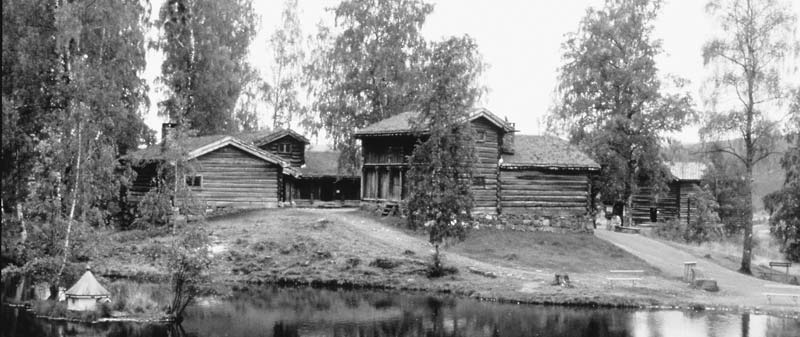
Norway in a Nutshell is a great day trip, but with more time and a car, consider a scenic meander from Oslo to Bergen. You’ll arc up the Gudbrandsdal Valley and over the Jotunheimen Mountains, then travel along the Lustrafjord.
After an introductory stop in Lillehammer, with its fine folk museum, you might spend the night in a log-and-sod farmstead-turned-hotel, tucked in a quiet valley under Norway’s highest peaks. Next, Norway’s highest pass takes you on an exhilarating roller-coaster ride through the heart of the myth-inspiring Jotunheimen, bristling with Norway’s biggest mountains. Then the road hairpins down into fjord country.
While you could spend five or six days in this area on a three-week Scandinavian rampage, this slice of the region is worth three days. By car, I’d spend them like this:
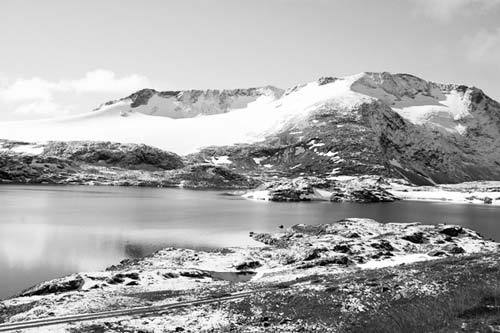
Day 1: Leave Oslo early, and spend midday at Lillehammer’s Maihaugen Open-Air Folk Museum for a tour and picnic. Drive up the Gudbrandsdal Valley, stopping at the stave church in Lom. Stay overnight in the Jotunheimen countryside.
Day 2: Drive the Sognefjell road over the mountains, then down along the Lustrafjord, stopping to visit the Dale Church and the Nigard Glacier. Sleep in your choice of fjord towns.
Day 3: Cruise the Aurland and/or Nærøy fjords and try to visit another stave church or two before carrying on to Bergen.
This plan can be condensed into two days if you skip the Nigard Glacier side-trip.
The Gudbrandsdal Valley is the tradition-steeped country of Peer Gynt, the Norwegian Huck Finn. This romantic valley of timeworn hills, log cabins, and velvet farms has connected northern and southern Norway since ancient times. While not as striking as other parts of the Norwegian countryside, Gudbrandsdal offers a suitable first taste of the natural wonders that crescendo farther north and west (in Jotunheimen and the Sognefjord). Throughout this region, the government subsidizes small farms to keep the countryside populated and healthy. (These subsidies would not be permitted if Norway were a member of the European Union.)
The de facto capital of Gudbrandsdal, Lillehammer, is a pleasant winter and summer resort town of 25,000. While famous for its brush with Olympic greatness (as host of the 1994 Winter Olympiad), Lillehammer is a bit disappointing—worthwhile only for its excellent Maihaugen Open-Air Folk Museum, or to break up the long drive between Oslo and the Jotunheimen region. If you do wind up here, Lillehammer has happy, old, woody pedestrian zones (Gågata and Storgata).
Lillehammer’s TI is inside the train station (mid-June-mid-Aug Mon-Fri 8:00-18:00, Sat-Sun 10:00-16:00; mid-Aug-mid-June Mon-Fri 8:00-16:00, Sat 10:00-14:00, closed Sun; Jernbanetorget 2, tel. 61 28 98 00, www.lillehammer.com).
Lillehammer’s two most worthwhile sights are up the hill behind the center of town. It’s a fairly steep 15-minute walk from the train station to either sight and a 10-minute, mostly level walk between the two (follow the busy main road that connects them). Because the walk from the station is uphill (and not very well-signed), consider catching the bus from in front of the train station (bus #003 to Olympics Museum, 2/hour; bus #006 to Maihaugen, 1/hour; 30 kr one-way for either bus).
▲▲Maihaugen Open-Air Folk Museum (Maihaugen Friluftsmuseet)—This idyllic park, full of old farmhouses and pickled slices of folk culture, provides a good introduction to what you’ll see as you drive through the Gudbrandsdal Valley. Anders Sandvig, a “visionary dentist,” started the collection in 1887. You’ll divide your time between the fine indoor museum at the entrance and the sprawling exterior exhibits.
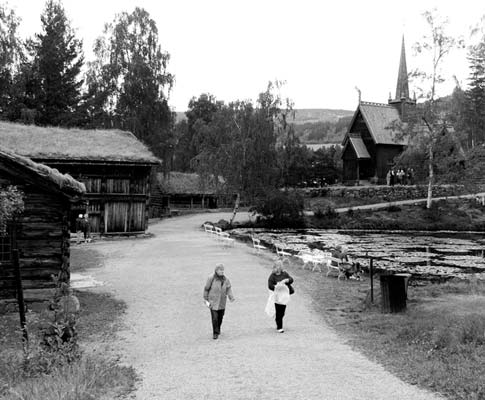
Upon arrival, ask about special events, crafts, or musical performances. A TV monitor shows what’s going on in the park. Summer is busy with crafts in action and people re-enacting life in the past, à la Colonial Williamsburg. There are no tours, so it’s up to you to initiate conversations with the “residents.” Off-season it’s pretty dead, with no live crafts and most buildings locked up.
Cost and Hours: 150 kr in summer, 110 kr off-season; 25 percent off when combined with Olympics Museum; June-Aug daily 10:00-17:00; Sept-May Tue-Sun 11:00-16:00, closed Mon; paid parking.
Information: Because English descriptions are scant, the 95-kr English guidebook is worth considering; tel. 61 28 89 00, www.maihaugen.no.
Visiting the Museum: The outdoor section, with 200 buildings from the Gudbrandsdal region, is divided into three areas: the “Rural Collection,” with old sod-roof log houses and a stave church; the “Town Collection,” with reconstructed bits of old-time Lillehammer; and the “Residential Area,” with 20th-century houses that look like most homes in today’s Norway. The time trip can be jarring: In the 1980s house, a bubble-gum-chewing girl enthused about her new, “wireless” TV remote and played ABBA tunes from a cassette-tape player.
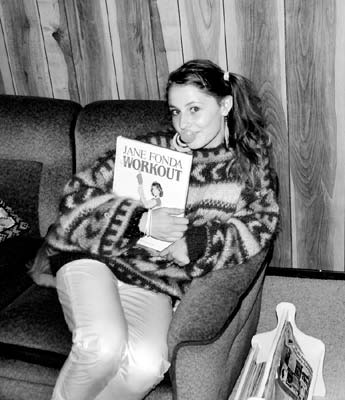
The museum’s excellent “We Won the Land” exhibit (at the entry) sweeps you through Norwegian history from the Ice Age to the Space Age. The Gudbrandsdal art section shows village life at its best. And you can walk through Dr. Sandvig’s old dental office and the original shops of various crafts- and tradespeople.
Though the museum welcomes picnickers and has a simple cafeteria, Lillehammer’s town center (a 15-minute walk below the museum), with lots of fun eateries, is better for lunch (see “Eating in the Gudbrandsdal Valley,” later).
Norwegian Olympics Museum (Norges Olympiske Museum)—This cute museum is housed in the huge Olympic ice-hockey arena, Håkon Hall. With brief English explanations, an emphasis on Norwegians and Swedes, and an endearingly gungho Olympic spirit, it’s worth a visit on a rainy day or for sports fans. The ground-floor exhibit traces the ancient history of the Olympics, then devotes one wall panel to each of the summer and winter Olympiads of the modern era (with special treatment for the 1952 Oslo games). Upstairs, walk the entire concourse, circling the arena seating while reviewing the highlights (and lowlights) of the 1994 games (remember Tonya Harding?). While you’re up there, check out the gallery of great Norwegian athletes and the giant egg used in the Lillehammer opening ceremony. With more time, see the 13-minute film on the 1994 Lillehammer Olympiad (included in museum ticket, 2/hour, usually in English, near ticket desk).
Cost and Hours: 110 kr, 25 percent off when combined with Maihaugen Museum; June-Aug daily 10:00-17:00; Sept-May Tue-Sun 11:00-16:00, closed Mon; tel. 61 25 21 00, www.maihaugen.no.
Nearby: On the hillside above Håkon Hall (a 30-minute hike or quick drive) are two ski jumps that host more Olympics sights, including a ski lift, the ski jump tower, and a bobsled ride (www.olympiaparken.no). In the summer, ski jumpers practice on the ski jumps, which are sprayed with water.
If you’re driving from Oslo to the Gudbrandsdal Valley, you’ll go right past the historic Eidsvoll Manor.
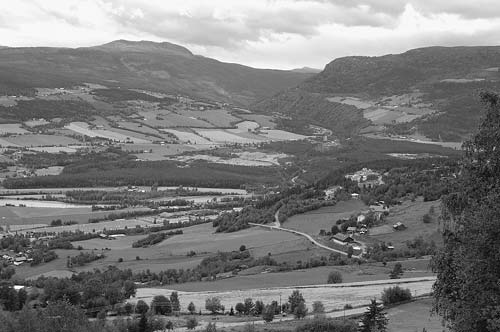
Scenic Drives—The main E-6 road north of Lillehammer (en route to Otta and Lom) passes through a bucolic valley with fine but unremarkable scenery. Along this road, a pair of toll-road side-trips (Gynt Veien and Peer Gynt Seterveien) loop off the E-6 road. While they sound romantic, they’re basically windy, curvy dirt roads over high, desolate heath and scrub-brush plateaus with fine mountain views. They’re scenic, but pale in comparison to the Sognefjell road between Lom and the Lustrafjord (described later in this chapter).
I prefer sleeping in the more scenic and Norwegian-feeling Jotunheimen area (described later). But if you’re sleeping here, Lillehammer and the surrounding valley offer several good options. My choices for Lillehammer are near the train station; the accommodations in Kvam provide a convenient stopping point in the valley.
$$$ Mølla Hotell, true to its name, is situated in an old mill along the little stream running through Lillehammer. The 58 rooms blend Old World charm with modern touches. It’s more cutesy-cozy and less businesslike than other Lillehammer hotels in this price range (Db-1,000-1,450 kr depending on demand, elevator, free Internet access and Wi-Fi, a block below Gågata at Elvegata 12, tel. 61 05 70 80, fax 61 05 70 81, www.mollahotell.no, post@mollahotell.no).
$$$ First Hotel Breiseth is a business-class hotel with 89 rooms in a handy location directly across from the train station (Sb-880-1,100 kr, Db-1,320 kr, free Wi-Fi, free parking, Jernbanegaten 1-5, tel. 61 24 77 77, www.firsthotels.no/breiseth, breiseth@firsthotels.no).
$ Vandrerhjem Stasjonen, Lillehammer’s youth hostel, is actually upstairs inside the train station. With 100 beds in 34 institutional but new-feeling rooms—including 18 almost hotel-like doubles—it’s a winner (340-kr bunk in a 3- to 4-bed dorm, Sb-700 kr, Db-890 kr, 15 percent cheaper for members, includes sheets and breakfast, elevator, free Wi-Fi, Jernbanetorget 2, tel. 61 26 00 24, www.stasjonen.no, post@stasjonen.no).
This is a popular vacation valley for Norwegians, and you’ll find loads of reasonable small hotels and campgrounds with huts for those who aren’t quite campers (hytter means “bungalows,” rom is “private room,” and ledig means “vacancy”). These huts normally cost about 400-600 kr, depending on size and amenities, and can hold from four to six people. Although they are simple, you’ll have a kitchenette and access to a good WC and shower. When available, sheets rent for around 60 kr per person. Here are a couple of listings in the town of Kvam, located midway between Lillehammer and Lom.
$$$ Vertshuset Sinclair has a quirky Scottish-Norwegian ambience. The 15 fine rooms are in old-fashioned motel wings, while the main building houses an inexpensive cafeteria, described below (Sb-890 kr, Db-1,090 kr, family deals, free Internet access and Wi-Fi, tel. 61 29 54 50, fax 61 29 54 51, www.vertshuset-sinclair.no, post@vertshuset-sinclair.no). The motel was named after a Scotsman who led a band of adventurers into this valley, attempting to set up their own Scottish kingdom. They failed. All were kilt.
$-$$ Kirketeigen Ungdomssenter (“Church Youth Center”), behind the town church, welcomes travelers year-round (camping spots-120 kr/tent; small cabins without water-400 kr; cabins with kitchen and bath-800 kr, sleeps up to 5 people; simple 4-bed rooms in the main building-450 kr for 2-4 people with sheets; sheets and blankets-100 kr, Wi-Fi, tel. 61 21 60 90, www.kirketeigen.no, post@kirketeigen.no).
In Lillehammer: Good restaurants are scattered around the city center, but for the widest selection, head to where the main pedestrian drag (Gågata) crosses the little stream running downhill through town. Poke a block or two up and down Elvegata, which stretches along the river and hosts a wide range of tempting eateries—from pubs (both rowdy and upscale) to pizza and cheap sandwich stands.
In the Valley: Vertshuset Sinclair, described above, has a cafeteria handy for a quick and filling bite on the road between Lillehammer and Lom (50-70-kr sandwiches, 100-180-kr meals, daily 7:00-2:30 in the morning).
Norway’s Jotunheimen Mountains (“Giants’ Home”) feature the country’s highest peaks and some of its best hikes and drives. This national park stretches from the fjords to the glaciers. You can play roller-coaster with mountain passes, take rugged hikes, wind up scenic toll roads, get up close to a giant stave church...and sleep in a time-passed rural valley. The gateway to the mountains is the unassuming town of Lom.
Pleasant Lom—the main town between Lillehammer and Sogndal—feels like a modern ski resort village. It’s home to one of Norway’s most impressive stave churches. While Lom has little else to offer, the church causes the closest thing to a tour-bus traffic jam this neck of the Norwegian woods will ever see.
Park by the stave church—you’ll see its dark spire just over the bridge. The church shares a parking lot with a gift shop/church museum and some public WCs. Across the street is the TI. If you’re heading over the mountains, Lom’s bank (at the Kommune building) has the last ATM until Gaupne.
Lom’s TI is an excellent source of information for hikes and drives in the Jotunheimen Mountains (mid-June-mid-Aug Mon-Fri 9:00-19:00, Sat-Sun 10:00-19:00; shorter hours off-season, closed Sat-Sun Oct-April; in the sod-roofed building across the busy road from the stave church parking lot, tel. 61 21 29 90, www.visitjotunheimen.com).
The TI also serves as a national park office and hosts a worthwhile Mountain Museum (Norsk Fjellmuseum), tracing the history of the people who have lived off the land in Jotunheimen from the Stone Age to today. This is one of the better exhibits in fjord country. Its theater shows a 10-minute montage of images backed by Kenny G-type music, and the displays are well-presented, with plenty of actual historic artifacts (50 kr, same hours as TI). The museum also has a computer with free Internet access for travelers.
Despite extensive renovations, Lom’s church (from 1158) remains a striking example of a Nordic stave church.
Cost and Hours: Church—55 kr, daily mid-June-mid-Aug 9:00-19:00, May-mid-June 10:00-17:00, mid-Aug-Sept 9:00-17:00, closed in winter and during funerals, fine 15-kr leaflet; museum—15 kr, mid-July-mid-Aug daily 9:00-20:00, progressively shorter hours in shoulder season, in winter Mon-Sat 10:00-15:00, closed Sun; tel. 61 21 73 00.
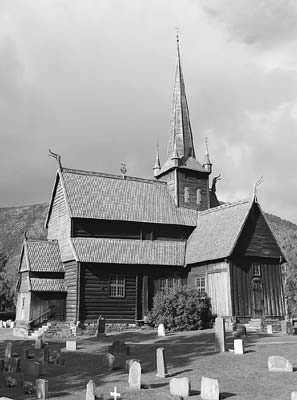
Tours: Try to tag along with a guided tour of the church—or, if it’s not too busy, a docent can give you a quick private tour (included in ticket). Even outside of opening times—including winter—small groups can arrange a tour (45 kr/person, 300-kr minimum, call 97 07 53 97 in summer or 61 21 73 00 in winter).
Visiting the Church: Buy your ticket and go inside to take in the humble interior (still used by locals for services—notice the posted hymnal numbers). Men sat on the right, women on the left, and prisoners sat with the sheriff in the caged area in the rear. Standing in the middle of the nave, look overhead to see the earliest surviving parts of the church, such as the circle of X-shaped St. Andrew crosses and the Romanesque arches above them. High above the door (impossible to see without a flashlight—ask a docent to show you) is an old painting of a dragon- or lion-like creature—likely an old Viking symbol, possibly drawn here to smooth the forced conversion local pagans made to Christianity. When King Olav II (later to become St. Olav) swept through this valley in 1021, he gave locals an option: convert or be burned out of house and home.
On the white town flag, notice the spoon—a symbol of Lom. Because of its position nestled in the mountains, Lom gets less rainfall than other towns, so large spoons were traditionally used to spread water over the fields. The apse (behind the altar) was added in 1240, when trendy new Gothic cathedrals made an apse a must-have accessory for churches across Europe. Lepers came to the grilled window in the apse for a blessing. When the Reformation hit in 1536, the old paintings were whitewashed over. The church has changed over the years: Transepts, pews, and windows were added in the 17th century. And the circa-1720 paintings were done by a local priest’s son.
Drop into the gift shop/church museum in the big black building in the parking lot. Its one-room exhibit celebrates 1,000 years of the stave church—interesting if you follow the loaner English descriptions. Inside you’ll find a pair of beautiful model churches, headstones and other artifacts, and the only surviving stave-church dragon-head “steeple.” In the display case near the early-1900s organ, find the little pencil-size stick carved with runes, dating from around 1350. It’s actually a love letter from a would-be suitor. The woman rejected him, but she saved them both from embarrassment by hiding the stick under the church floorboards beneath a pew...where it was found in 1973. (Docents inside the church like to show off a replica of this stick.)
Before or after your church visit, explore the tidy, thought-provoking graveyard surrounding the church. Also, check out the precarious-looking little footbridge over the waterfall (the best view is from the modern road bridge into town).
Lom itself has a handful of hotels, but the most appealing way to overnight in this area is at a rural rest stop in the countryside. All of these are on Route 55 south of Lom, toward Sognefjord—first is Strind Gård, then Bøverdalen, Røisheim, and finally Elvesæter (all within 20 minutes of Lom).
$$$ Røisheim, in a marvelously remote mountain setting, is an extremely expensive storybook hotel composed of a cluster of centuries-old, sod-roofed log farmhouses. Its posh and generous living rooms are filled with antiques. Each of the 20 rooms (in eight different buildings) is rustic but elegant, with fun “barrel bathtubs” and four-poster or canopy beds. Some rooms are in old, wooden farm buildings—stabburs—with low ceilings and heavy beams. The deluxe rooms are larger, with king beds and fireplaces. Call ahead so they’ll be prepared for your arrival (open May-Sept; standard Db-3,600 kr, deluxe Db-3,950 kr; includes breakfast, packed lunch, and an over-the-top four-course traditional dinner served at 19:30; non-smoking, free Wi-Fi, 10 miles south of Lom on Route 55, tel. 61 21 20 31, fax 61 21 21 51, www.dvgl.no, booking@roisheim.no).
$$$ Elvesæter Hotel has its own share of Old World romance, but is bigger, cheaper, and more modest. Delightful public spaces bunny-hop through its traditional shell, while its 200 beds sprawl through nine buildings. The Elvesæter family has done a great job of retaining the historic character of their medieval farm, even though the place is big enough to handle large tour groups. The renovated “superior” rooms are new-feeling, but have sterile modern furniture; the older, cheaper “standard” rooms are well-worn but more characteristic (open May-Sept, standard Db-1,150 kr, superior Db-1,550 kr, extra bed-450 kr, family deals, includes breakfast, good 325-kr three-course dinners, strictly non-smoking, free Wi-Fi, swimming pool, farther up Route 55, just past Bøverdal, tel. 61 21 99 00, fax 61 21 99 01, www.topofnorway.no, elveseter@topofnorway.no). Even if you’re not staying here, stop by to wander through the public spaces and pick up a flier explaining the towering Sagasøyla (Saga Column). It was started in 1926 to celebrate the Norwegian constitution, and was to stand in front of Oslo’s Parliament Building—but the project stalled after World War II (thanks to the artist’s affinity for things German and membership in Norway’s fascist party). It was eventually finished and erected here in 1992.
$ Bøverdalen Youth Hostel offers 32 cheap-but-comfortable beds and a far more rugged clientele—real hikers rather than car hikers. While a bit institutional, it’s well-priced and well-run (open late May-Sept, bunk in 4- to 6-bed room-180 kr, D-480 kr, 4-person cabins-700 kr, sheets-65 kr, breakfast-80 kr, free Wi-Fi, kitchen, hot meals, self-serve café, tel. & fax 61 21 20 64, www.hihostels.no, boverdalen@hihostels.no, Anna Berit). It’s in the center of the little community of Bøverdal (store, campground, and toll road up to Galdhøpiggen area).
$ Strind Gård is your very rustic option if you can’t spring for Røisheim or Elvesæter, but still want the countryside-farm experience. This 150-year-old farmhouse, situated by a soothing waterfall, rents two rooms and one apartment, plus four sod-roofed log huts. The catch: Many of the buildings have no running water, so you’ll use the shared facilities at the main building. While not everyone’s cup of tea, this place will appeal to romantics who always wanted to sleep in a humble log cabin in the Norwegian mountains—it’s downright idyllic for those who like to rough it (2-person huts: without bathroom-300-500 kr depending on size, beautiful private hut with bathroom-700 kr; rooms in main house: D-400-500 kr depending on size, apartment for 4-6 with private bath-700 kr; sheets and towels-70 kr, no breakfast, free Wi-Fi, low ceilings, farm smells, valley views, 2 miles south of Lom on Route 55, tel. 61 21 12 37, www.strind-gard.no, post@strind-gard.no, Anne Jorunn and Trond Dalsegg).
Route 55, which runs between Lom and the Sognefjord to the south, is the sightseeing spine of this region. From this main (and already scenic) drag, other roads spin upwards into the mountains—offering even better views and exciting drives and hikes. Many of these get you up close to Norway’s highest mountain, Galdhøpiggen (8,100 feet). I’ve listed these attractions from north to south, as you’ll reach them driving from Lom to the Sognefjord; except for the first, they all branch off from Route 55. Another great high-mountain experience nearby is the hike to the Nigard Glacier near Lustrafjord.
Remember that the TI in Lom acts as a national park office, offering excellent maps and advice for drivers and hikers—a stop here is obligatory if you’re planning a jaunt into the mountains (see “Orientation to Lom,” earlier).
This trail offers an incredible opportunity to walk between two lakes separated by a narrow ridge and a 1,000-foot cliff. It’s one of Norway’s most beloved hikes, which can make it crowded in the summer. To get to the trailhead, drivers detour down Route 51 after Otta south to Maurvangen. Turn right to Gjendesheim to park your car. From Gjendesheim, catch the boat to Memurubu, where the path starts at the boat dock. Hike along the ridge—with a blue lake (Bessvatnet) on one side and a green lake (Gjende) on the other—and keep your balance. The six-hour trail loops back to Gjendesheim. Because the boat runs sporadically, time your visit to catch one (120 kr for 20-minute ride, 3 morning departures daily, latest schedules at www.gjende.no, tel. 61 23 85 09). This is a thrilling but potentially hazardous hike, and it’s a major detour: Gjendesheim is about 1.5 hours and 50 miles from Lom.
From Røisheim, this 11-mile toll road (50 kr) takes you from Route 55 to the Spiterstulen mountain hotel/lodge in about 30 minutes (3,600 feet). This is the best destination for serious all-day hikes to Norway’s two mightiest mountains, Glittertinden and Galdhøpiggen (a 5-hour hike up and a 3-hour hike down, doable without a guide). Or consider a guided, two-hour glacier walk (tel. 61 21 94 00, www.spiterstulen.no).
This toll road takes you (in about 40 minutes) to the highest you can drive and the closest you can get to Galdhøpiggen (6,050 feet) by car. The road starts in Bøverdal, and costs 85 kr; at the end of it, daily, guided, six-hour hikes go across the glacier to the summit and back (200 kr, late June-late Sept daily at 10:00, July-mid-Aug also daily at 11:30, check in 30 minutes before, strict age limit—no kids under age 7, 4 miles each way, easy ascent but very dangerous without a guide, hiking boots required—possible to rent from nearby ski resort). You can sleep in the newly updated $$$ Juvasshytta lodge (Db-1,100 kr with sheets, D without sheets-860 kr, sheets-100 kr, includes breakfast, dinner-330 kr, open June-Sept, tel. 61 21 15 50, www.juvasshytta.no).
This 11-mile, 50-kr toll road (about 30 minutes one-way from Bøverkinnhalsen, south of Elvesæter) is most scenic for car hikers. It takes you to a lodge at 4,600 feet with great views and easy walks. A serious (5-hour round-trip) hike goes to the lone peak, Kyrkja—“The Cathedral,” which looms like a sanded-down mini-Matterhorn on the horizon (6,660 feet).
Norway’s highest pass (at 4,600 feet, the highest road in northern Europe) is a thrilling drive through a cancan line of mountains, from Jotunheimen’s Bøverdal Valley to the Lustrafjord (an arm of the Sognefjord). Centuries ago, the farmers of Gudbrandsdal took their horse caravans over this difficult mountain pass on treks to Bergen. Today, the road (Route 55) is still narrow, windy, and otherworldly (and usually closed mid-Oct-May).
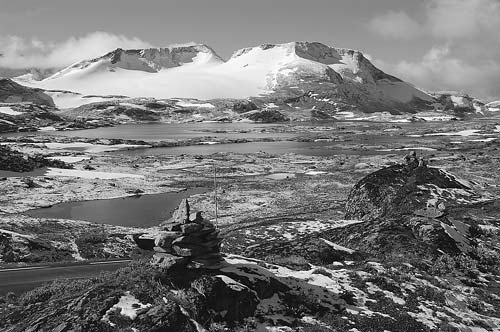
As you begin to ascend just beyond Elvesæter, notice the viewpoint on the left for the Leirdalen Valley—capped at the end with the Kyrkja peak (described earlier). Then you’ll twist up into a lake-filled valley, then through a mild canyon with grand waterfalls. Before long, as you corkscrew up more switchbacks, you’re above the tree line, enjoying a “top of the world” feeling. The best views (to the south) are of the cut-glass range called Hurrungane (“Noisy Children”). The 10 hairpin turns between Turtagrø and Fortun are exciting. Be sure to stop, get out, look around, and enjoy the lavish views. Treat each turn as if it were your last.
Just before you descend to the fjord, the terrain changes, and you reach a pullout on the right, next to a hilltop viewpoint—offering your first glimpse of the fjord. The Lustrafjord village of Skjolden is just around the bend (and down several more switchbacks). Entering Skjolden, continue following Route 55, which now traces the west bank of the Lustrafjord.
Cars are better, but if you’re without wheels: Oslo to Lillehammer (trains almost hourly, 2.5 hours, just 2 hours from Oslo airport), Lillehammer to Otta (6 trains/day, 1.5 hours); a bus meets some trains (confirm schedule at the train station in Oslo) for travelers heading on to Lom (2 buses/day, 1 hour) and onward from Lom to Sogndal (2 buses/day late June-Aug only, road closed off-season, 3.25 hours).
Use low gears and lots of patience both up (to keep the engine cool) and down (to save your brakes). Uphill traffic gets the right-of-way, but drivers, up or down, dive for the nearest fat part of the road whenever they meet. Ask backseat drivers not to scream until you’ve actually been hit or have left the road.
From Oslo to Jotunheimen: It’s 2.5 hours from Oslo to Lillehammer and 3 hours after that to Lom. Wind out of Oslo following signs for E-6 (not to Drammen, but for Stockholm and then to Trondheim). In a few minutes, you’re in the wide-open pastoral countryside of eastern Norway. Norway’s Constitution Hall—Eidsvoll Manor—is a five-minute detour off E-6, several miles south of Eidsvoll in Eidsvoll Verk (follow the signs to Eidsvoll Bygningen). Then E-6 takes you along Norway’s largest lake (Mjøsa), through the town of Hamar, and past more lake scenery into Lillehammer. Signs direct you uphill from downtown Lillehammer to the Maihaugen Open-Air Folk Museum. From Lillehammer, signs to E-6/Trondheim take you up the valley of Gudbrandsdal. At Otta, exit for Lom. Halfway to Lom, on the left, look for the long suspension bridge spanning the milky-blue river—a good opportunity to stretch your legs, and a scenic spot to enjoy a picnic.